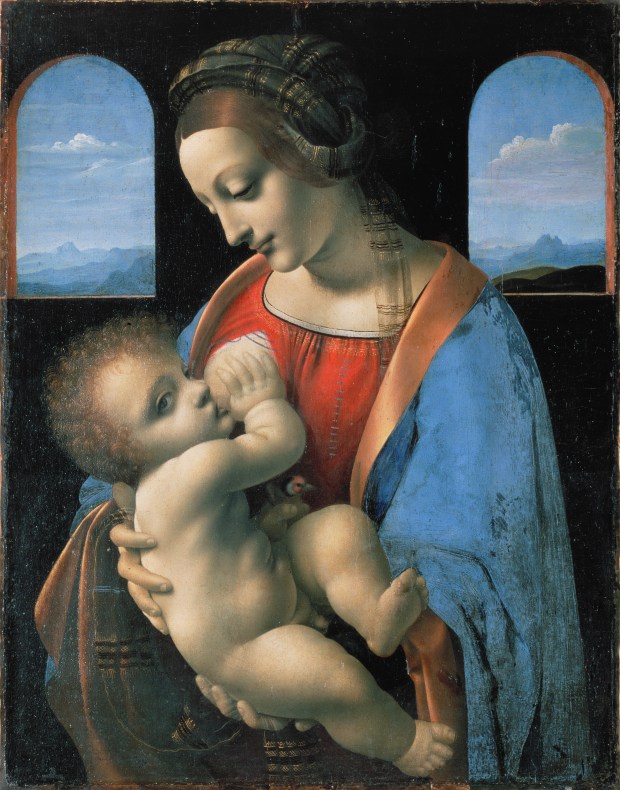Lenten Campaign 2025
This content is free of charge, as are all our articles.
Support us with a donation that is tax-deductible and enable us to continue to reach millions of readers.
From the Pietas to the Virgin of the Rocks, there have been countless striking depictions of the Virgin Mary in art. But on Mother's Day it is particularly appropriate to highlight the maternity of the Virgin Mary as seen in the paintings known as the “Nursing Madonnas.”
Here, the Blessed Mother is represented as she is breastfeeding Christ Child, a very human gesture that spoke of Mary’s humility.
Early examples of Nursing Madonnas
It’s hard to tell when the first painting of the Nursing Madonna was created, but most art historians agree that the tradition started around the 12th century in Italy and in other Western European countries, and that it was especially prominent in Tuscany and Spain. One much earlier example, found in a fresco in the Priscilla Catacombs in Rome, dating from the 2nd century, is a stand-alone case of Nursing Madonna in ancient art.
One of the earliest examples of medieval Madonna Lactans, a 12th-century mosaic on the facade of Santa Maria in Trastevere in Rome, shows the virgin Mary offering her breast to Christ child as she is surrounded by 10 female figures, eight of whom are wearing royal regalia and two that are more simply dressed. Art historians believe the mosaic was a reference to the Parable of the Ten Virgins, a story in which 10 virgins wait for a bridegroom, but half of them forget to bring both a lamp and lamp oil thus missing the chance to meet the groom when he finally arrives late at night.
What’s interesting is that in this representation, both the Madonna and Christ Child are looking away from the viewer. The Christ Child is represented as looking up to Virgin Mary, while she is looking towards her right. Some hundred years later this same subject would often be represented with both subjects gazing at the viewer, something that further increased the intimacy of the scene. For example, in a famous golden panel kept at the Louvre, Italian medieval painter Barnaba da Modena depicts both the Virgin Mary and Christ Child as deeply gazing towards the viewer.
As explained in the blog Renaissance Reframed, while the act of nursing was the central subject of these paintings, an equally important role was played by the gaze of Christ whose “direct eye contact with the viewer served to draw the viewer into the scene and engage them in this extremely human and physical interaction.”
Somewhere in between these two iconographic setups we find this 1270 altarpiece representing different chapters of the life of St. Peter. Here, the Madonna looks at the viewer while Christ Child is looking at her.
What the many representations of the Nursing Madonna have in common is the profound emphasis on the physicality of the Blessed Mother, something that can be associated with the “Madonna of Humility,” an iconographic tradition depicting Mary with humble clothing.
In both of these representations, viewers are invited to meditate on the humanity and sacrifice of the Blessed Mother. In the Nursing Madonnas, the focus is especially on the Blessed Mother’s gift of breastfeeding, a symbol not only of her motherhood of Christ but also of the nursing aspect of Virgin Mary’s love towards believers. Furthermore, art historians believe that these sets of paintings were meant to highlight the strong connection between the Blessed Mother's milk and the blood of Christ.
Raphael and Da Vinci
Among the great masters who worked on the subject were Raphael and (probably) Leonardo. A 15th-century painting attributed to Leonardo da Vinci and preserved at St. Petersburg’s Hermitage Museum shows the Madonna staring lovingly towards the Christ Child, who in turn looks at the viewer with a poignant gaze while a goldfinch, a symbol of his future Passion, stands in between mother and child. The works by Raphael on this subject differ from earlier examples, as the Madonna is not represented during breastfeeding but simply in the act of holding the Christ Child. Still, many consider some of these paintings, such as the 1508 Niccolini-Cowper Madonna preserved at the National Gallery in London, as a “Madonna Lactans.”
Popular devotion
Over the centuries, the Madonna Lactans became a popular inspiration for believers praying for conception. In the Spanish speaking world, “Nuestra Señora de la Leche y Buen Parto,” literally Our Lady of Milk and Good Childbirth, inspired prayers from those trying to conceive. Prospective parents in Italy often travel to the Sanctuary of the Madonna of Milk in Guanzate, near Como. In Israel, the Milk Grotto, built on the place where according to tradition a drop of milk was spilled from the Virgin’s body, turning the floor of the chapel white, attracts people from all over the world searching for help in childbearing. And in Florida, the Shrine of Our Lady of Milk, built by the Spanish in 1620 in St. Augustine, has served a similar purpose, with thousands of people traveling from across the country when trying to conceive a child.
While the Madonna Lactans was increasingly abandoned by artists following a decision by the Council of Trent regarding the appropriateness of certain religious representations, the concept of Mary as a sacrificing, nurturing mother still inspires people all over the world.













